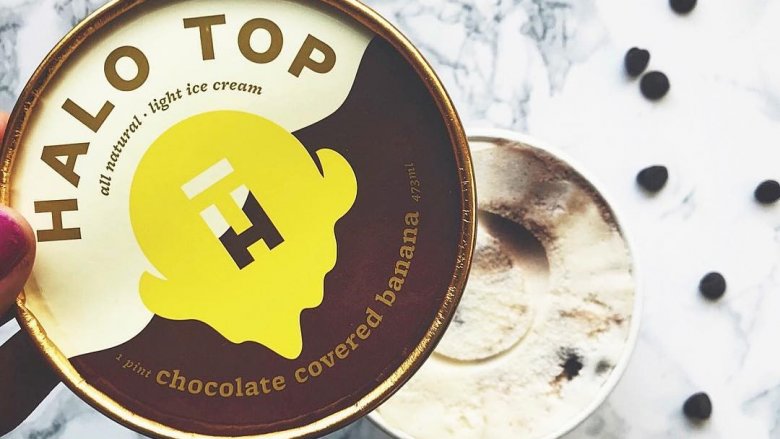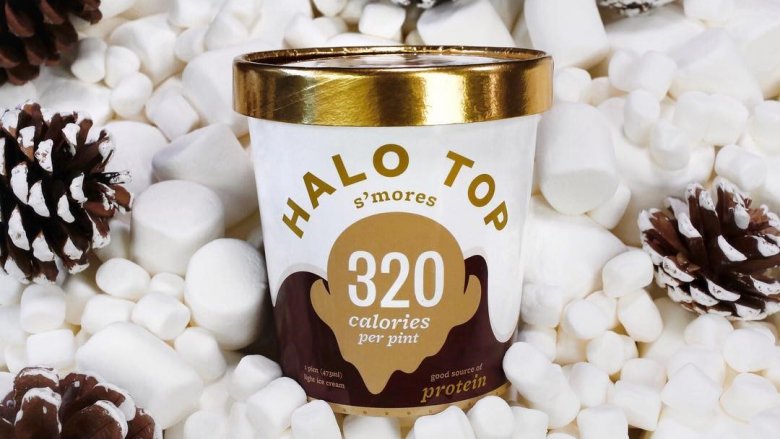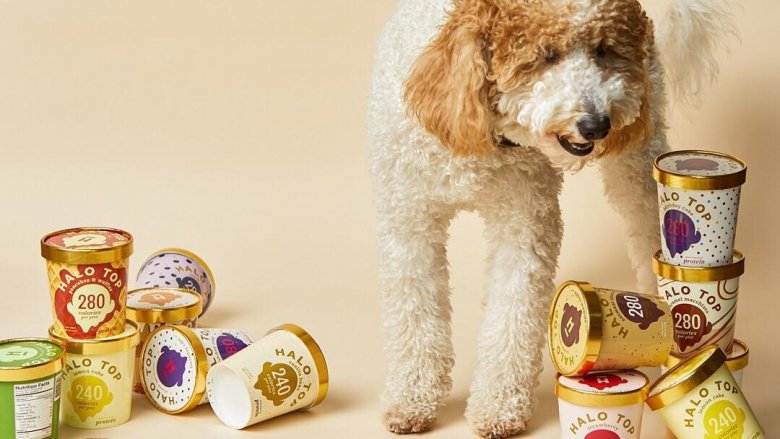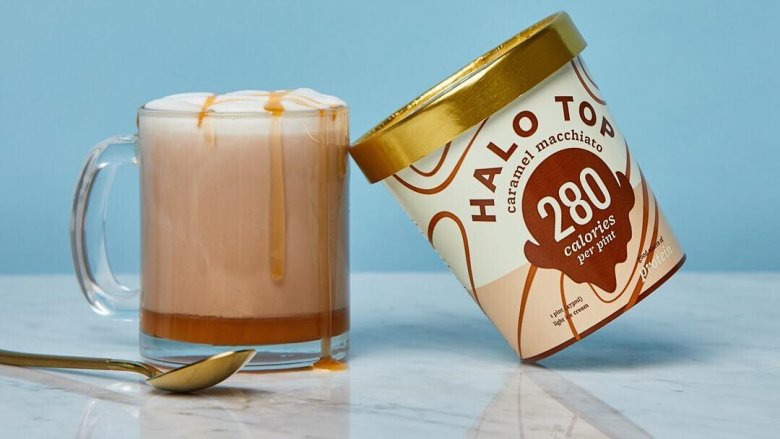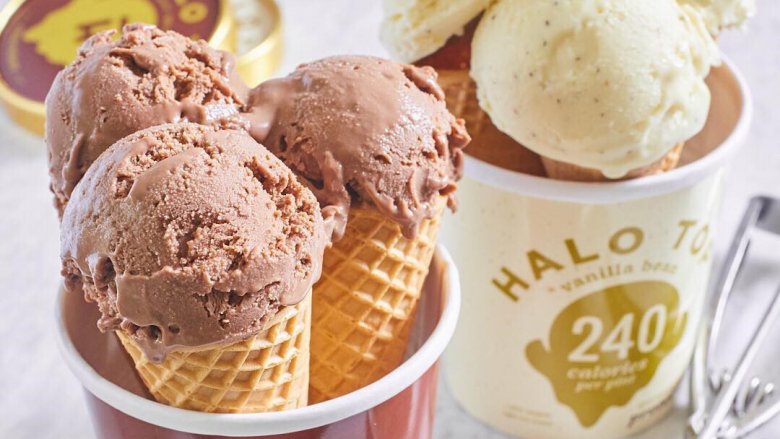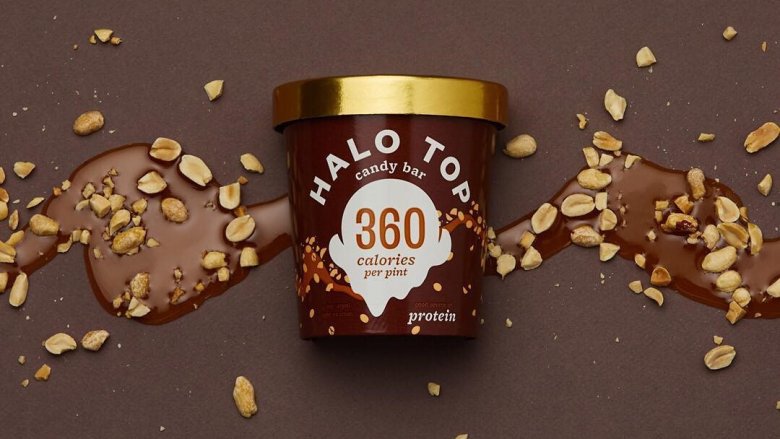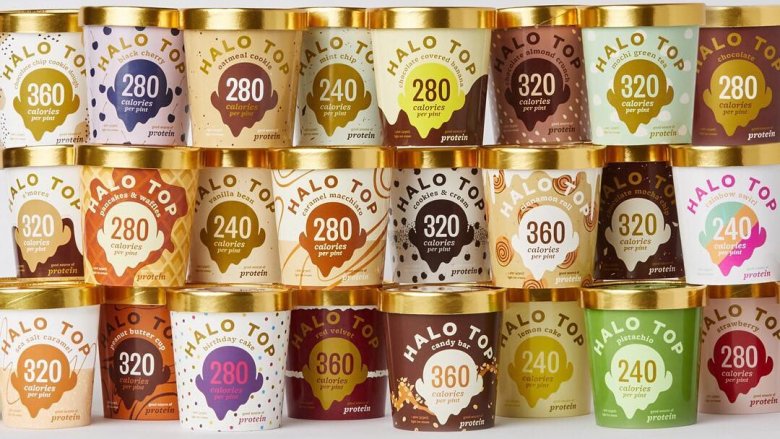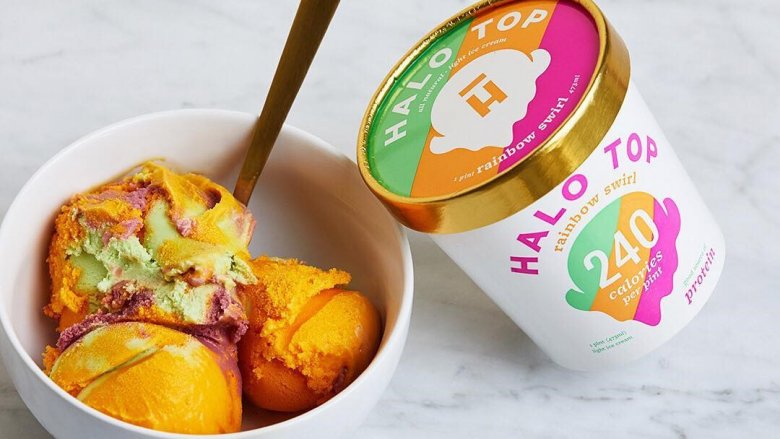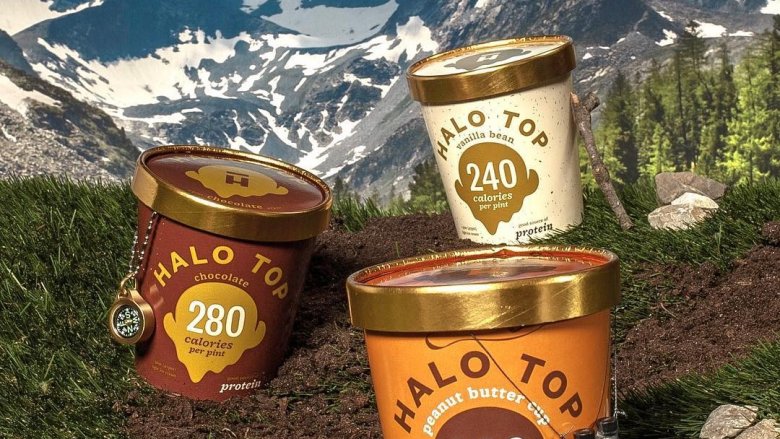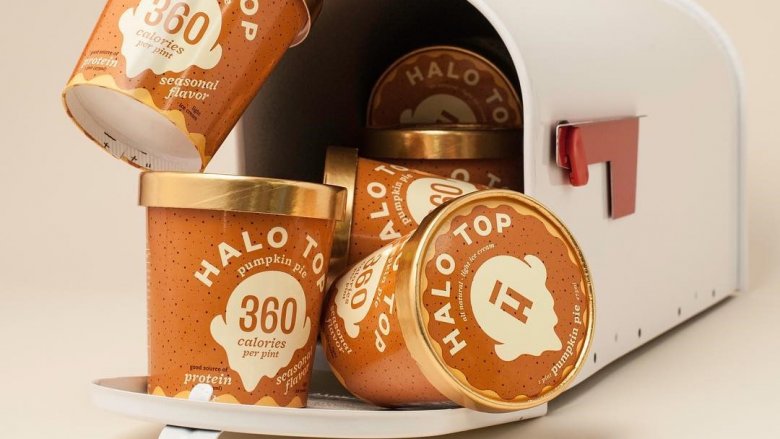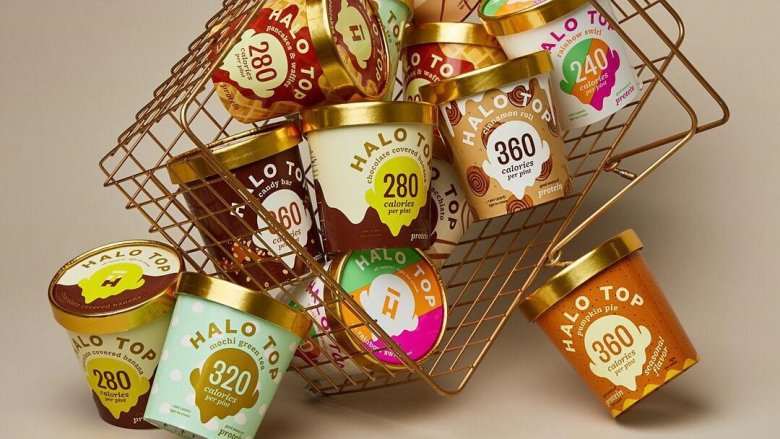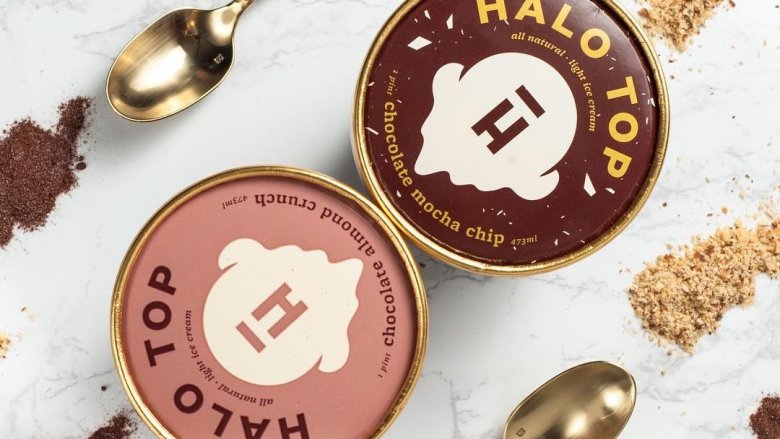The Untold Truth Of Halo Top Ice Cream
Halo Top bills itself as a guilt-free ice cream. That's as close to real magic as the world is ever going to get, so if you're a little skeptical, you're completely forgiven. Surely, it doesn't taste as good as the real thing, or there's a hidden catch. There's got to be, right? Let's find out.
Is it bad for your gut?
According to Halo Top's official ingredient list, most of the sweetness comes from organic stevia. You're familiar with that, but you're probably less familiar with the other secret ingredient: erythritol. Today says it's been used for years in the diet versions of all your favorite sweets — it's a naturally-occurring sugar that doesn't have the negative impact on blood sugar levels we've all come to expect. This stuff was huge in the '90s, but there was a side effect: pretty severe gastrointestinal distress.
There's the catch, right? Not exactly. A study led by the University of Tokyo looked at how much erythritol would have to be consumed to cause distress in a healthy adult. In fact, you'd have to eat about three pints of Halo Top to ingest enough erythritol to feel any discomfort (via Fortune). You do stop at one, right?
It was created by an attorney with a sweet tooth
Pick up a pint (or seven) of Halo Top, and you're not supporting a big corporation. You're supporting ex-attorney Justin Woolverton and his relatively small (but growing) team. Woolverton was working as an LA lawyer (and not loving it), when a simple kitchen experiment changed everything. When he talked to CBS News, he said a huge part of what drove him to come up with Halo Top were his own difficulties with sugar. "My body doesn't do well on sugar. When you have a hypoglycemic episode, you just turn white... You look like a zombie."
Not content with what he found at the store, he sprung for a $20 ice cream maker and started experimenting. When he hit on the recipe that later became Halo Top, he told the Los Angeles Times, "I thought, 'This is really good. I'll bet others will like it, too.'" First on board was another disillusioned lawyer, Doug Bouton. They met through an amateur basketball league, and the rest is dessert history.
They broke the mold... literally
That first attempt wasn't the ice cream you're enjoying when you dip into — and, let's be honest, finish off — a pint of today's Halo Top. They had to make a few changes, and it wasn't always smooth sailing.
Woolverton told the Los Angeles Times that he started small, convincing grocery stores like Whole Foods to give his product some shelf space. But, with the long the ride and the change in altitude it went through on the way to the store... it didn't hold up. Enter some food science.
The first commercial version of the high-protein ice cream was so thick it destroyed machinery — it was too thick to get through pipes. Woolverton said, "It was like a movie. It's trying to go through the aluminium tubes. I'm sitting there watching and thinking, 'Do I need to move out of the way? Oh, no, it's going into the red." That was about the time bolts started coming loose, and fortunately, the ice cream maker was willing to let them have another go... once they tweaked their recipe.
It caused a near-death experience... twice
Halo Top might be touted as a healthy ice cream, but it almost killed the company's founder. How? It's a strange story that Justin Woolverton told Inc.
In the earliest days of the company, Woolverton packed samples of ice cream in dry ice, stashed them in the back seat of his car, and drove them around. He was sitting in a traffic jam just outside West Hollywood when he started having trouble breathing. That turned into hyperventilating, heading toward fainting. Fortunately, there was an ambulance stuck in traffic next to him, and he flagged them down and stumbled out of the car.
It was the dry ice. It's great for keeping ice cream at the perfect temperature because there's no liquid to make a mess, but once it start evaporating, it raises the percentage of carbon dioxide in the air. Sitting in a parked car is the perfect environment for that to happen and bizarrely, it happened to Bouton, too. Lesson (eventually) learned!
The science of sweet
Halo Top has a few innovative ingredients, but there's also some pretty cool science going on to make this lighter-than-light, frosty creation taste like the ice cream you crave.
When The Cut talked to Woolverton about the idea behind Halo Top, he was mum on most of the details. But he did talk a bit about how they tapped into the science of flavor, starting with how our taste buds work. A study published in the Journal of Dairy Science proved we're actually pretty terrible at detecting the difference in fat levels in things like ice cream. Fat content could vary as much as four percent and participants were none the wiser, and while that doesn't sound like a lot, it helps save around 154 calories per pint. So, Halo Top uses only the lower-fat parts of the ingredients that add a rich texture, like milk and eggs.
And, one more thing. Halo Top is obviously cold, which works in its favor. Cold has a numbing effect on your taste buds, so not as much sweet is actually needed. Science!
Is a pint an actual pint?
Finish off a pint of Halo Top, and you'll notice something a bit odd. You won't feel like you've just eaten a whole pint. That's partially because even though you've just eaten a pint, you've actually eaten less ice cream than you would have if you'd picked up, say, a pint of Ben & Jerry's.
Halo Top has a ton of air in it — about ¾ of a cup in every pint. It's part of that flavor science that helps fool us into thinking we're eating something full of fat and sugar, but it also means a pint only weights around 256 grams. Compare that to a more traditional pint that Food & Wine says weighs in at between 400 and 450 grams, and now you know why you can still get up off the couch after polishing off that pint.
Their Halo has started some trouble
Halo Top wasn't always called Halo Top. According to CNBC, Woolverton originally settled on the name Eden Creamery and sold it under that name for a year, but changed the name early on to avoid lawsuits from the many other Eden-named companies in the world.
That change didn't get them entirely out of the woods, though. In 2017, NJ.com reported that New Jersey dairy Halo Farm — which counts ice cream and milk among their products — filed a lawsuit against Halo Top. The problem started when the California company started appearing on shelves in New Jersey, and the suit claims the similar names are confusing customers into believing Halo Farms products are healthy, low-fat, or low-sugar. Halo Farm also cites the potential for stevia and erythritol to cause gastrointestinal distress and discomfort in their suit, saying their products don't contain it and they don't want to be confused with those that do.
What's the real deal with the health claims?
We know what you're thinking. A low-calorie, low-sugar, high-protein ice cream that tastes as good as you hope still has to have a catch, right? Here's the thing. Time talked to Woolverton about the health claims that went along with Halo Top, and this is what he had to say: "Everybody has their own definition of healthy. For us, [it means] foods that are as unprocessed as they can be. ... It can fit into [a] diet without breaking the calorie bank."
On the other side are nutritionists, who warn there's a danger in Halo Top. Barry Popkin of the University of North Carolina (via Fortune) says Halo Top's boast that you can eat the whole pint and not feel guilty isn't helping people struggling with things like binge eating and portion control. Others are also concerned that relying on Halo Top as a source of protein means you're not getting the nutrients and vitamins that come with a well-rounded diet. So, being a better choice doesn't make it a great choice, but if you're trying to eat better and you need to satisfy that sweet tooth... dig in!
Social media saved the day
Halo Top's success has been due, in large part, to social media. Woolverton founded the company in 2011, but Adage says it wasn't until 2016 that sales jumped a shocking 2500 percent. That was, in part, thanks to a rave review in GQ written by a journalist who embarked on a mission to eat nothing but Halo Top for ten days. Not only did he survive to tell the tale, but he lost weight... and bought a couple more pints of chocolate after finishing off 50 pints.
His story went viral on social media, and that kicked off Halo Top's popularity. Since then, they've stayed true to the idea behind the company. You'll see some television ads, sure, but Woolverton says all their marketing is done in-house. Their ads are spread through Facebook, Twitter, and Instagram, and success came just in time, too. The boom happened when they were running out of cash. After spending hundreds of thousands in design and development, resorting to high-interest loans, and maxing out credit cards, the company almost folded instead of taking off.
The Halo diet: too good to be true?
Fad diets are nothing new, and Halo Top isn't even the weirdest of them all. But it might sound like the best by a long shot, so that brings up an important question: does it work?
Let's start with GQ's Shane Snow, who wrote about his ten days eating only ice cream. For him, it worked. Snow ate five pints a day, with mild side effects like headaches, chills, a craving for salt, low energy, and the inconvenience of a canker sore. But he also dropped 10 pounds, 3 percent body fat, and an inch and a half off his waist.
He's not the only one that's done it with some success. Yahoo editors who tried it lost an average of 2 pounds each over the course of three days, and Spoon University's Meredith Davin lost 1.4 pounds. That's not too shabby, and while there are certainly less delicious-sounding fad diets you can go on, we also have to point out again that nutritionists don't recommend it.
They're an ally
In August 2017, the gay dating app Grindr took another step into broadening their online presence. They launched the companion lifestyle site, Into, with the hopes of attracting companies who wanted to put their advertising dollars into a site that would help them reach the LGBTQ community. Two organizations jumped on board immediately: FX's show American Horror Story: Cult, and Halo Top. AdWeek says scrolling ads for the two brands featured heavily in the site's launch, with Into showrunners hoping they're going to lead the way for other advertisers who want to reach a new market that might not be as heavily catered to by other sites and publications.
Ice cream of the dystopian future
Halo Top isn't your usual ice cream, and some of their advertisements seem designed to remind you of that. You know the one we're talking about, too, the dystopian, sci-fi-inspired ad where a robot relentlessly feeds a confused woman ice cream. It's the kind of ad you remember, even if you don't remember what it's for. According to Woolverton, they weren't at all concerned it might give people the creeps. He told Delish, "We wanted to do something that's a reflection of our company — we're a collection of personalities here, not a big, corporate structure — and give our fans something they could enjoy."
AdWeek reached out to the commercial's creator, Mike Diva. He explained that the creepy, weirdly unsettling commercial was meant to grab the audience's attention, while not necessarily selling how great their product is. Sure, it's dark, but it's also the kind of funny you laugh at... even if you won't admit to it. Diva said it's not just his style, but credited Woolverton for having the same sense of humor and the confidence to bet the bank on the fact it wouldn't turn people off from eating his ice cream.
